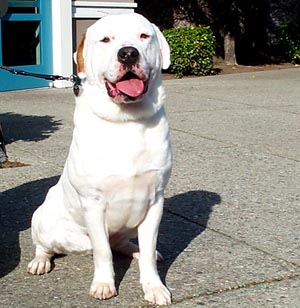My Thanksgiving Wish
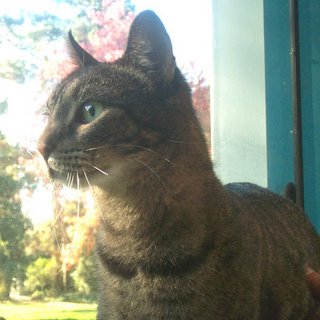
Well, here I am at the shelter for Thanksgiving. This is the perfect place to reflect on all that I am thankful for this past year.
I am thankful that our community helped us in welcoming 28 animals who survived Hurricane Katrina. Thankful that we could house and treat these animals. Thankful to the foster volunteers who gave them a home to settle into. Thankful that we have been able to send so many of them back to their original families.
Some of the cats and dogs we took in from Louisiana have not had anyone call to claim them. In addition, a handful of these have medical issues which make them adoptable to homes who are ready to deal with their special needs.
In the photo above is Pierre, he is looking dreamily outside on a sunny day, but due to his FIV+ status he will need to be indoor only for life. He made it all this way to the Bay Area and we are hoping someone will find a space for him in their life despite this medical roadblock.
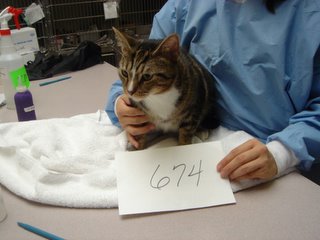
To the right is Henri. When he first arrived he was a number, but not for long. He is a true gentleman. His foster home raved about him, but we were concerned that his bloodwork might have indicated a fatal viral disease. Today, although he still tests positive for the virus, it does not seem to be causing any illness and may never. He is ready to charm himself into someone's heart.
Finally, I sat and shared a bit of breakfast burrito with my pal Gumbo. You may know of him from past posts. Well, he appears to be doing well and at this time is free of the symptoms of the tick borne illness babesia. He may always be at risk of this coming back, but after passing or behavior evaluations and being such a good dog in his foster home we believe he deserves a chance.
So, as we move through this winter holiday season, remember our special needs guests who weatherd a storm, but now really need a bit more good luck in finding a home. If you find yourself visiting us this season, be sure to come by and say "Hi" to these very special animals.
Sometimes we get it wrong.
We've got a
lot of happy endings at our shelters. The stories and pictures make us laugh and cry. Unfortunately, despite all our follow up phone calls, all of our adoption requirements, all of our dog training classes, and all of our support, not every ending is happy:
This week we saw
1) One dog returned after two years. He was adopted as a puppy and chained in the backyard the entire time. He is now aggressive, fearful, and downright scary at this point. Not the puppy we adopted out two years ago.
2) A dog adopted in May that was dumped at a county shelter. He was scheduled to be euthanized today, but luckily, a staff person there noticed it had our microchip and asked if we wanted him back. We got him back today.
3) Two dogs adopted in late 2004 (one a puppy in September, and then another dog in November) were picked up for severe neglect and abuse. They are being housed at local city shelter pending the investigation. The city employee said one could barely walk.
4) A dog adopted just a month ago was found wandering the streets and was, again, luckily brought back to us. We haven't made contact with the owner yet. Do they notice he is missing?
Sometimes we just get it wrong.
Who in their right mind would foster?
That's what I wonder sometimes.
I mean, seriously, here's the pitch we make (paraphrased):
"Please take this pet (or pets) into your home. Since they may be sick and carrying some kind of nasty disease, you have to keep them completely separated from your own pets, so just go ahead and block off a room in your house just for foster animals. You have the room, don't you? Now, since these are kittens/puppies/sick animals, they will, of course, stink it up frequently. That won't be a problem, will it?"
"Did you know kittens are nocturnal? That means you can be entertained by various objects being batted across the floor in the middle of the night, usually followed by the 'thud' from mid-air collisions. Don't be scared: there is no burgular ransacking your house. It's just kittens.""The pet has regular appointments at the shelter for medical care or vaccinations, and you'll need to transport him since we can't. Our hours are probably not in sync with your schedule so this may even involve taking time off of work. Of course, if your foster pet gets critically sick, you may need to bring him to the shelter regardless of the time. What else did you have to do at 3 a.m.?"
"Sometimes, ill and underage pets die." And if that isn't enough to run you off, we remind you to please plan on paying for all the food and litter.
Isn't this an insane volunteer position? Well, I think so, but somehow we have 188 foster families on file. (I confess: I am one, too.) All of them don't foster regularly, but have at least once.
In 2005, our foster parents have provided temporary care and shelter for over 1,500 animals. Most of these were underage kittens, waiting to reach eight weeks old, when they can safely be altered then live in the shelter awaiting adoption. These are lives saved.
Without foster homes, these kittens would not find a place in our county and would be killed.
Sometimes I get apologetic for even asking if the foster will another animal. But then, there are the fosters like Alison P., who had had to leave us with "her" kittens while she was out of town...but amazingly wanted them back when she returned. She really, really wanted to see them again. Imagine!
So, this Blog's for you, Foster Familes. All 188 of you.
We hope she feels the same.
We work with a lot of other shelters and rescue groups here at the EBSPCA. We think these kinds of collaborative relationships are critical to our mission and we certainly could not have gotten where we have in Alameda county in terms of lower euthanasia rates without them.
Sometimes it is hard because the rescue folks, mostly volunteers doing this on their own time and dime, want to save them all. They get so disappointed when we can't take a dog they brought or a cat they suggested we look at. They get sad and every so often, mad.
But there is one volunteer we work with that really "gets it". She volunteers with a local "friends of" group near our facilities and we communicate regularly. She not only brings us cats and dogs, but she keeps us informed on local goings on and animal welfare politics in our community and even volunteers at our shot fair. She doesn't just want us to come test their dogs. She wants to know the outcome of the test to ensure unsafe animals aren't being put out in the community.
She also gets the pit bull problem. A pit bull and american bull dog lover, she and her group have been providing vouchers for free and low cost spays and neuters for pit bulls for years now.
She is passionate and dedicated, but not crazy and extremist (like so many others). We value our relationship and we hope she feels the same.
What's In A Name
It often falls to we shelter staff to name incoming animals. Most dogs and cats arrive at the EBSPCA with no name at all, and a select few will cringe and cower when called by their current name.
Names should encapsulate the animal's personality, but we don't always have the time or luxury of spending days deciding on just the right nom de plum. However, there are the rare occasions where we just hit the nail on the head and pick the perfect name. Below are some dogs who've passed through our halls with what I consider to be excellent names. Not all of them still have said names, but these are the titles I remember them by.

Frodo
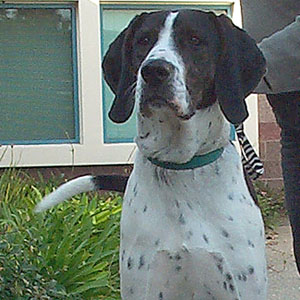
Gomer

Crouton

Peaches
 Petunia
Petunia
Snuffles
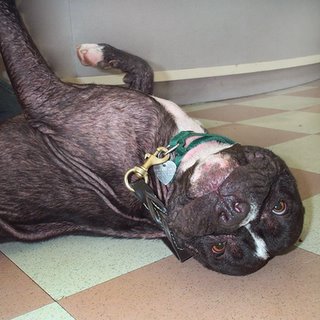
Boris Krinkles

Froggy

Hector Bean
I can't wait to see who adopts them.
We currently offer free feral cat surgeries on a drop in basis at our Oakland spay neuter facility after a referral is received from
Fix our Ferals or
ICRA. We take in as many as there is space available. This past Wednesdsay, we took in 18! To ensure we are consistent with our clients who trap, and are truly helping feral, unhandleable cats, we have a few requirements to qualify for the free, feral surgery:
- All cats must come in in traps.
- All cats will have their ears notched (this is proof the cat was fixed, so as to not bring it in twice.)
- All cats must be over 4 months.
The trappers are fine with all the requirements except the last one. With the explosion of kittens each Spring and Fall, there are just so many being born to feral cats. It can become hard on the pocketbook to pay for all the kitten surgeries.
So, why do we have this requirement? We have it because kittens under that age can usually still be tamed to be nice, sweet pets. Many people don't believe me when I say that. And they don't believe me when they are trying to catch a three-month-old kitten that is hissing and spitting all over the place.
But last week, I got the chance to put my money where my mouth is. A trapper came in with a mama and three kittens. I explained the rules and she paid for the kittens' surgery. But she was also at a complete loss as to what to do with these kittens. After a long conversation, I proposed to her that we take the kittens, tame them and put them up for adoption. I was pleased with myself, until I tried to pick up the kittens. Boy, were they hissy! One got loose and it took three people and a net to get him back.
What had I done? Should these kittens have been re-released with their mama to spend their life as outside feral cats? Did I bite off more than I could chew?
But I held firm. I was confident that we could tame those kittens! We put them in cages, separated from each other to reduce the "pack" mentality. Then, I labeled the cages "DO NOT HANDLE: MANAGER ONLY" so that no unsuspecting volunteers or staff would let them out or try to pick them up. Then I explained to L. the shelter manager what needed to be done: "3 to 4 times a day, pick them up, wrap them in a towel, like a burrito, and hold them tight." Scratching them, talking to them, and singing to them would help. L. was skeptical, but she was up for the challenge.
I checked in with the kittens three days later and the difference was amazing! One was at the front of the cage, purring. The other, after one short hiss, succumbed to belly rubs. They were almost ready, but not quite.
Three more days later, you would have never known that these were the same kittens that eluded a net and three trained technicians. Purring and sweet, cuddling and loving, they were the picture of cuteness. It was great to see.
But it was even more great to see the smile on the L's face. She had taken these kittens from a life on the street and turned them into fabulous pets. She did it and she was proud. And I felt good that my stubborness to prove a point paid off. I can't wait to see who adopts them.
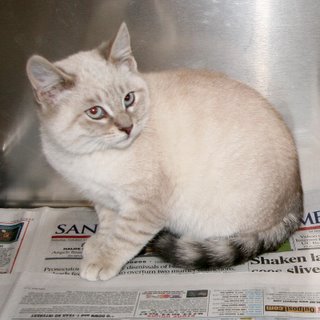


At least he got his pit bull fixed.
I was helping out at our Tri Valley Spay Neuter Surgery Center yesterday and a client came about 30 minutes early to pick up his dog. I told him to wait and I would see if she was ready (awake, walking, etc) yet. I went to the back and sure enough, she was ready to go home.
I brought her out front and the client was sooooo happy to see her. He had been so worried about her and got their early to make sure she was ok. I told him she was fine and everything went well.
He then asked if she should get a e-collar (those big collars that animals wear to keep them from licking themselves). I told him that unless he knew she was a "licker" it usually isn't necessary. He still seemed concerned. I told him that he could certainly get one, but that it would cost $15. He then said, "Money is no object when it comes to my baby."
Which, as a stand alone statement, coming from a big burly guy who was worried about his dog, is really quite sweet. The part I found slightly amusing, if not slightly annoying, is that the owner did not pay for the surgery. He, despite money being no object, took advantage of our Free Pit FIx program and got the spay surgery done for free.
Ah well...at least he got his pit bull fixed.
Fix Your Feline for Free!
Our first ever Fix Your Feline For Free Day was great. 89 cats were spayed or neutered for free. Here is the day captured in pictures.
THESE KITTIES HAVE JUST BEEN CHECKED IN...

NOW THE TECHS PREP THEM FOR SURGERY...
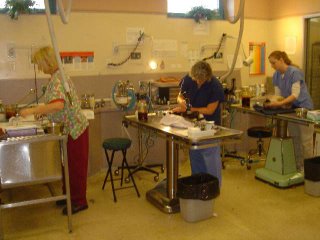
EACH CAT IS SHAVED AND...

GIVEN ANESTHESIA...
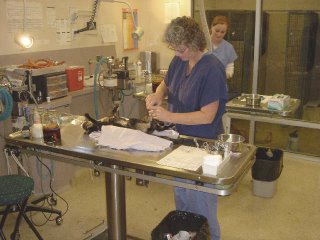
THEN THE DOCTORS PERFORM THE SURGERY...
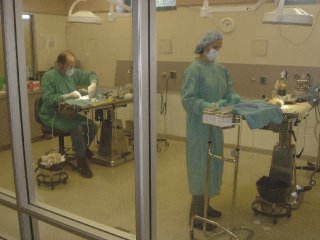
THE CATS RECOVERY UNDER OUR CLOSE WATCH...

WE HAD EXTRA STAFF THERE THAT DAY TO ENSURE ALL WENT WELL...

EVEN OUR VOLUNTEERS HELPED CLEANING PACKS AND DOING LAUNDRY...

AND NOW THE CATS ARE READY TO BE PICKED UP!

I think my son might become a dog trainer.
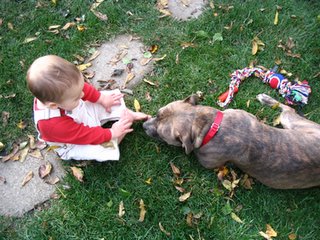
So I'm fostering another dog for BADRAP as part of my educational efforts to learn more about Pit Bulls and about the BADRAP process. The new dog is named Cleo and came from Oakland Animal Services last week. She is doing well and will get into Pit Bull Hall next week sometime.
Today, as Cleo and my 11 month old were hanging out in the living room, completely supervised of course, my son did something that cracked me up.
He went over to Cleo, stuck out his little hand, pulled up her lip and then swiped her muzzle a couple times. Then he turned around and grabbed her tail. He laughed with delight and Cleo, the perfect Pit Bull, didn't care one bit about this type of handling.
The funny thing about this is that this "handling" is part of our temperament test at the East Bay SPCA. We call it "teeth level 1" and "muzzle 1". We submissively, like a child, lift up the lip to see the dog's teeth, making cooing and ooohing sounds as we do it. Most dogs don't mind this in the least, but there are some who take this behavior quite badly and will snap back in an aggressive way. Same with muzzle 1. Three small swipes on the muzzle with just two fingers tries to mimic what any child might do. And before we do all this, we touch their paws, body and, yes, tail, to ensure the dog can stand to be handled in these ways.
So, even though I haven't ever seen this before, I got validation tonight that our test certainly does have real life meaning. I also got validation that Cleo is an absolute temperament correct pit bull. And lastly, I think my son might become a dog trainer.
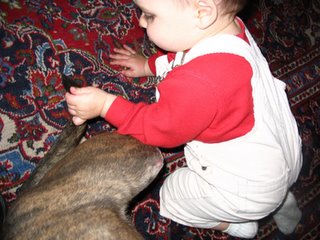
The Blues
Every dog we take into the SPCA is a risk. Temperament tests are not an exact science. They are a snapshot; a moment in time. Dogs who pass their primary and secondary evaluations are very likely to be of a stable, safe temperament. There are no guarantees.
A few months ago, we took a very big risk and brought four blue pit bull puppies into the Oakland SPCA. Puppies are even harder to predict than adults because they're still in the process of becoming. Who a puppy is at ten weeks may not be who he is at twelve or sixteen weeks. The "switches" in the brain are being flicked on one by one, and as a puppy changes physically, behavior issues can develop. That makes any puppy a risk.
Pit bull puppies are even more likely to have issues because we know they are being carelessly and unintentionally bred in the Bay Area. Worse, some pit bulls are intentionally bred for temperaments that would make them unsuitable as safe companions. If you've read other blog posts, you already know that pit bulls are still flooding the shelters even as most other breeds' overpopulation is getting under control. They are a breed in crisis, and that unfortunately means that young, abandoned pit bull puppies are temperament wild cards.
Within the breed, the silvery-grey coat color known as
"blue" has become highly desirable. The color blue is a somewhat uncommon one, and any time an uncommon color becomes popular, it means trouble for a dog breed. Because Dalmations
MUST have that spotty coat, one out of every four are
born deaf. The public's desire for
blue merle Australian Shepherds resulted in careless breeding that created puppies often born
both deaf and vision impaired.
Harlequin Great Dane puppies often suffer the
same fate, and don't even get me started on
"white" Doberman Pinschers.
Science doesn't know exactly how coat color and these other genetic traits are linked, but breeding has shown us time and time again that it is connected. On a very basic level, the fewer variables you allow into a breeding program, the smaller the gene pool. The smaller the gene pool, the more problems you'll have. This is why every single pure breed has at least one health problem commonly affiliated with it. Now, take that already small gene pool, narrow it down to only a single color scheme and you haven't so much got a pool as you've got a puddle. Problems are inevitable. Responsible breeders of any breed will not risk the health of their lines just for the latest coat color fad, but those people breeding dogs for quick profit would rather sell the most popular aesthetic than bother with such trivial things as stable temperament and physical soundness.
The result for the pit bull population has been an explosion of beautiful silvery-grey pit bulls with fearful, panicky, quick-to-snap personalities. In a relatively nearby shelter, seven beautifully blue eight-week-old pit bull puppies were becoming available for adoption. The veterinarian working for the shelter was opposed to spaying or neutering earlier than six months, and so these highly desirable blue puppies of unknown temperament were going to be adopted out into the public unspeutered (spayed or neutered). Each puppy was going to go home with a spay/neuter waiver so the pup could be brought back and altered at six months. The adoption contract required the new owners to alter their dogs when they became six months old, but the truth was anyone could take one of these puppies home, choose not to fix him or her, and begin breeding.
The risk of taking these puppies into our shelter was nothing compared to the risk of putting them out into the public unaltered. We went down to get them they day they became available. By the time we arrived, three had already been adopted out. We gathered up the other four (all females) and headed back to the OSPCA.
Now the question became what to do with them. At eight weeks, all four puppies were behaving exactly as puppies should. They were interested in people, appropriately meek around older dogs, and curious but not frightened of the world around them. A great start, but only a start, and we had no way of predicting who they might become. On the other hand, we couldn't just stick them in a kennel and call them unavailable until they matured. It was time to try something new.
Each puppy became a special adoption. Those interested would fill out an application and allow a background check. We wouldn't adopt the puppies out to any first-time dog owners or to anyone under twenty-one. We wanted a home that had had experience with dogs and, ideally, experience with pit bulls. Each puppy would go into her potential home as a foster. Two series of classes, Puppy Preschool and Puppy Kindergarten, would be included in their foster period. This meant each puppy would be in a home for about three months without being officially adopted. During that time both the shelter and the potential adopters were allowed to call it quits at any time. We were looking to make sure the puppies continued to develop into normal, healthy, tempermentally-nice dogs. If they showed any signs of abnormal behavior, we would end the foster period and have the puppies returned to us. If at any point the foster felt they were unable to commit to the puppy in the way they'd originally intended, they were allowed to end the partnership as well. Our hope was that we'd minimize the risk and be more confident that all four were on their way to becoming well-behaved adult dogs. Graduation from Puppy Kindergarten class would also be official adoption day.
We named the four puppies Winifred, Edith, Gertrude, and Lillian. We spayed them and placed them up into adoptions. We assigned each puppy a trainer and taught interested volunteers how to help us socialize "the girls". And we waited.
None of us were surprised when the four pups sat in the kennels for a week. Then two. For many people looking for a puppy, pit bulls are already a hot-button topic. Now, we were asking for extra requirements to take one home? Why not just adopt a puppy of a different breed instead? But that was okay. We weren't looking to adopt the girls out to someone who wanted A puppy. We were waiting for the families who wanted THAT puppy.
Naturally, all four of the girls came down with kennel cough and spent some time in the back recovering. Volunteers were wonderful, doing everything from introducing the puppies to new toys to taking them on car rides. One by one, each puppy recovered and returned to adoptions. They each got a second DHPP vaccination and were allowed to play outside.
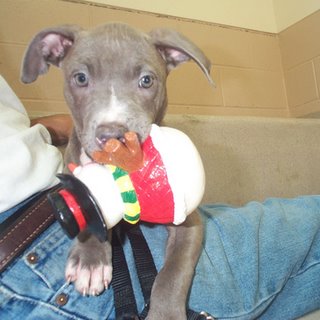
The first puppy to go home was Lillian. A young couple looking for an older pit bull instead fell for her hazel eyes and sensitive spirit. She was renamed "Winniford Pepperbottom" and after completing Puppy Preschool and Puppy Kindergarten, we hit a snag. Winnie began limping and the vets couldn't decide what was wrong with her. It's possible she may need surgery in the future, and even with this financial risk, she was offically adopted on graduation day of Puppy Kindergarten.

Several weeks later, it was Gertrude's turn. She went home with a family that had a toddler. Now renamed Deja, she solicits treats from her pint-sized playmate by sitting and staring adoringly into his eyes. She makes special effort to avoid jumping or jostling him and, even when running at full tilt, Deja will run around, rather than into, this youngest family member. She is pushy with other puppies, but plays better when allowed to carry a stuffed animal in her mouth. She was officially adopted only a few days ago.
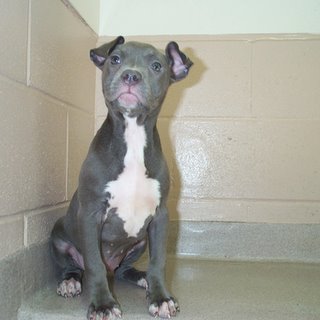
The two remaining puppies were three and a half months old before Winifred was chosen. She too went home with a young child, and the family will be attending Puppy Kindergarten in the new year. So far, she is settling in well.

Edith went home only last week, although she had been on someone's mind for a while before that. A woman from Manteca had recently lost her fourteen-year-old pit bull to cancer. Enchanted by Edith's photo on the website
Virtual Pet Adoptions, Edith served as her computer monitor's background for several weeks before the woman felt ready to drive to Oakland and meet her. Because Edith was now four and a half months old, and because this woman had come such a long way, we made an exception to the exception and allowed Edith to be officially adopted.
The story's not really over yet. It never is. But now, all four puppies have their tales continuing in new homes with new families. It was a long road to get there, but a road worth taking.
Looking forward to the next one.
Our second attempt at a shot fair was a wild success. We gave over 600 vaccinations and helped over 300 clients. The lines were long, the day was long, but reaching out to our community is also long overdue.
The goal of these shot fair, in addition to giving away free vaccinations, is to talk to people about spay neuter and microchips to reduce litters and aid in redemptions when owners lose their dogs and cats. To that end, we did over 130 microchips and signed up 60 people for free spay neuter surgeries. We also gave away a ton more vouchers for free surgeries. These vouchers are still coming in from our last shot fair in July.
All the volunteers from FOFAS to BADRAP and all the EBSPCA volunteers and staff were just super. My back was sore and my feet hurt, but the day was well worth it and we are all looking forward to the next one.

 To the right is Henri. When he first arrived he was a number, but not for long. He is a true gentleman. His foster home raved about him, but we were concerned that his bloodwork might have indicated a fatal viral disease. Today, although he still tests positive for the virus, it does not seem to be causing any illness and may never. He is ready to charm himself into someone's heart.
To the right is Henri. When he first arrived he was a number, but not for long. He is a true gentleman. His foster home raved about him, but we were concerned that his bloodwork might have indicated a fatal viral disease. Today, although he still tests positive for the virus, it does not seem to be causing any illness and may never. He is ready to charm himself into someone's heart.














